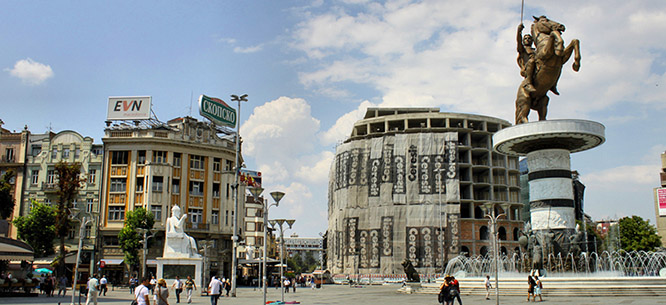Show Us Your Country: Macedonia’s Capital Transformed
Show Us Your Country: Macedonia’s Capital Transformed

Until recently, the city of Skopje in the former Yugoslavia was known, among those interested in urban development, largely for a single event: the 1963 earthquake that all but leveled the city. But today, under a nationalist government seeking to assert the country’s ancient history with Donald Trump–like bravado, the capital of Macedonia has come back on the architectural radar. Skopje’s ongoing makeover, at a cost of several hundred million euros, includes one of the largest statues in Europe, a new archaeological museum, and several works of public art, all financed by the government in an effort to paint their poverty-stricken state as the rightful inheritor of a distant grandeur. The problem is that history, even ancient history, is anything but uncontested in the Balkans.
Macedonia, like nearby Bosnia, is a young state fighting against wary neighbors for political recognition, ownership of historical figures, and linguistic autonomy. While it was spared the carnage of the Yugoslav wars of the 1990s, the country has encountered its own set of problems since achieving independence from the former federal republic in 1991: Greece contests Macedonia’s very right to exist under its current name; Bulgarian political organizations, often associated with the far right, claim Slavic Macedonians as their own; and Macedonia’s current right-wing government has almost no support from the country’s ethnic Albanians, who make up a quarter of the population. In the face of these perceived threats, both internal and external, the Macedonian authorities are seeking to shore up national identity by any means possible.
Skopje has become the ground zero of this struggle. The central plaza, which used to sport only modest flowerbeds, is now home to an eight-story-tall fountain and statue of Alexander the Great. Alexander, who is officially named “Warrior on a Horse,” raises his sword to the sky as his horse rears up on its hind legs; they appear poised to protect the city from imminent danger. Across the Vardar River, an equally large sculpture of Alexander’s father, Philip II of Macedon, was recently erected. Both are part of the Skopje 2014 plan—an ambitious, and largely aesthetic, remodeling of both Skopje and Macedonian nationalism with an estimated budget of 200 to 500 million euros. The plan owes its vigor to Macedonia’s forty-three-year-old prime minister Nikola Gruevski, who has been governing a center-right coalition since he was in his mid-thirties and wishes to present an equally fresh-faced capital to the European Union.
While heritage tourism has been a powerful economic buzzword in the countries of the European periphery for some time, this project goes a step further: it is an emphatic response to regional neighbors who have defied Macedonia to “show us your country” and an attempt to claim an autonomous national story that predates both Yugoslavia and the Ottoman Empire. The struggle just to defe...
Subscribe now to read the full article
Online OnlyFor just $19.95 a year, get access to new issues and decades' worth of archives on our site.
|
Print + OnlineFor $35 a year, get new issues delivered to your door and access to our full online archives.
|






